Financial Reporting: Purpose, Framework, Analysis, and Statements
VerifiedAdded on 2021/02/19
|14
|4013
|203
Report
AI Summary
This report provides a comprehensive overview of financial reporting. It begins by defining financial reporting and outlining its various purposes, such as providing information, supporting decision-making, regulating performance, and controlling financial data. The report then delves into the conceptual and regulatory frameworks, including GAAP and IFRS, highlighting their requirements and purposes. It emphasizes the importance of qualitative characteristics like relevance, reliability, understandability, and comparability. The report identifies and discusses various internal and external stakeholders, including employees, owners, suppliers, customers, and investors, detailing their respective interests in financial information. Furthermore, the report explores how financial reporting fulfills organizational objectives and promotes growth, emphasizing its role in benchmarking and decision-making. It includes sample financial statements (income statement, statement of changes in equity, and balance sheet) and concludes with an analysis of financial statements, including liquidity ratios and the differences between cash flow statements, financial positions, and income statements. The report aims to provide a clear understanding of the financial reporting process and its significance in an accountancy firm.
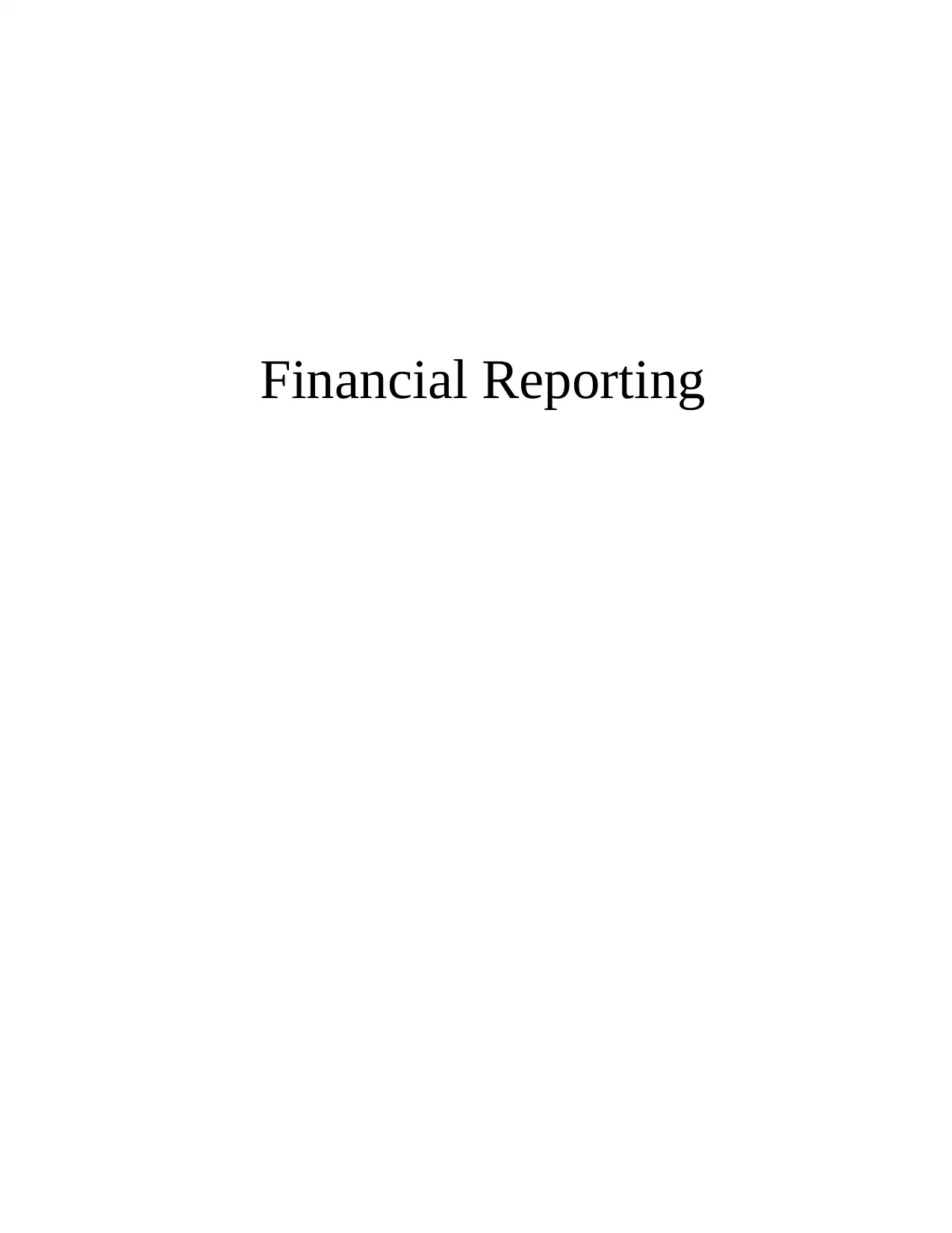
Financial Reporting
Paraphrase This Document
Need a fresh take? Get an instant paraphrase of this document with our AI Paraphraser

1
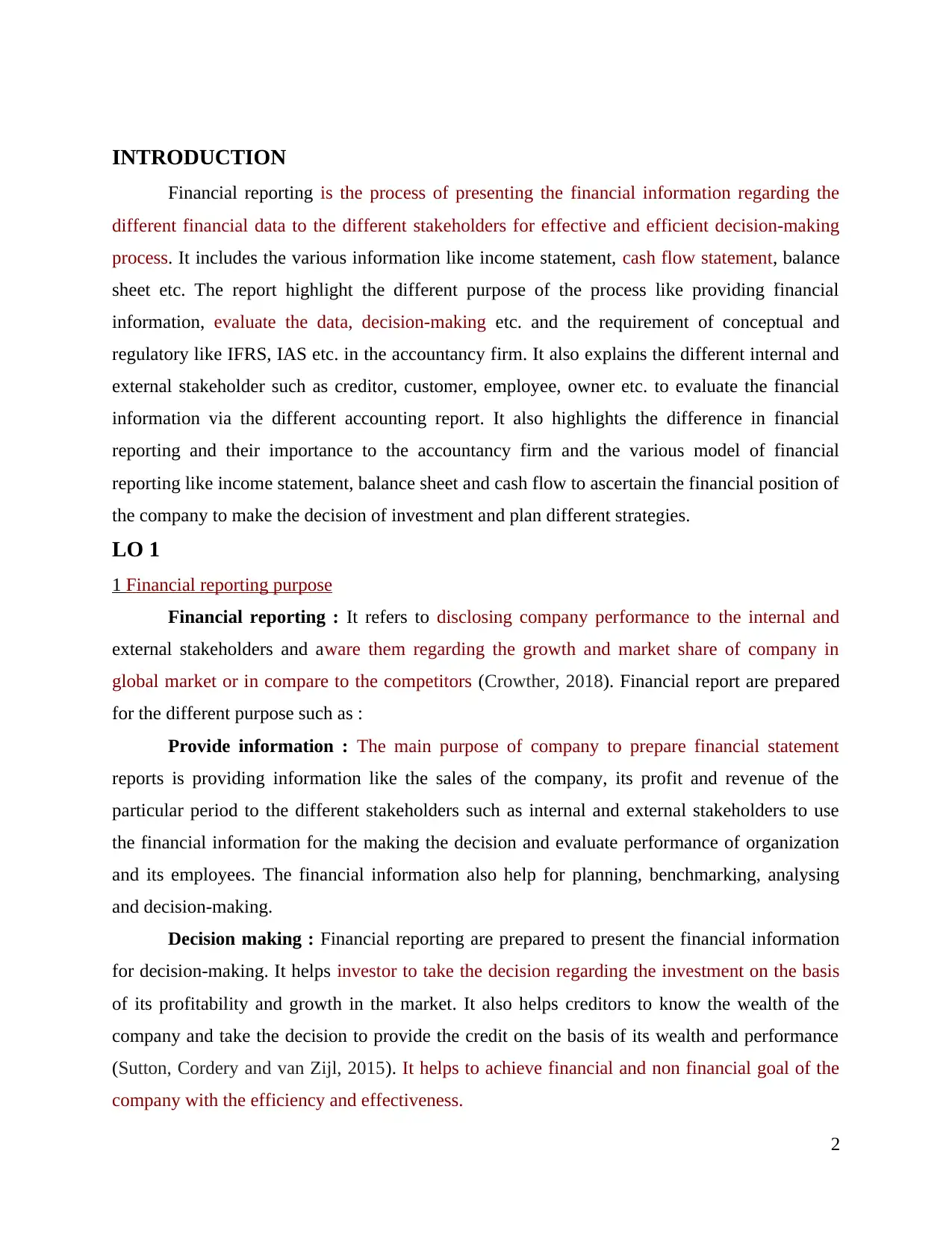
INTRODUCTION
Financial reporting is the process of presenting the financial information regarding the
different financial data to the different stakeholders for effective and efficient decision-making
process. It includes the various information like income statement, cash flow statement, balance
sheet etc. The report highlight the different purpose of the process like providing financial
information, evaluate the data, decision-making etc. and the requirement of conceptual and
regulatory like IFRS, IAS etc. in the accountancy firm. It also explains the different internal and
external stakeholder such as creditor, customer, employee, owner etc. to evaluate the financial
information via the different accounting report. It also highlights the difference in financial
reporting and their importance to the accountancy firm and the various model of financial
reporting like income statement, balance sheet and cash flow to ascertain the financial position of
the company to make the decision of investment and plan different strategies.
LO 1
1 Financial reporting purpose
Financial reporting : It refers to disclosing company performance to the internal and
external stakeholders and aware them regarding the growth and market share of company in
global market or in compare to the competitors (Crowther, 2018). Financial report are prepared
for the different purpose such as :
Provide information : The main purpose of company to prepare financial statement
reports is providing information like the sales of the company, its profit and revenue of the
particular period to the different stakeholders such as internal and external stakeholders to use
the financial information for the making the decision and evaluate performance of organization
and its employees. The financial information also help for planning, benchmarking, analysing
and decision-making.
Decision making : Financial reporting are prepared to present the financial information
for decision-making. It helps investor to take the decision regarding the investment on the basis
of its profitability and growth in the market. It also helps creditors to know the wealth of the
company and take the decision to provide the credit on the basis of its wealth and performance
(Sutton, Cordery and van Zijl, 2015). It helps to achieve financial and non financial goal of the
company with the efficiency and effectiveness.
2
Financial reporting is the process of presenting the financial information regarding the
different financial data to the different stakeholders for effective and efficient decision-making
process. It includes the various information like income statement, cash flow statement, balance
sheet etc. The report highlight the different purpose of the process like providing financial
information, evaluate the data, decision-making etc. and the requirement of conceptual and
regulatory like IFRS, IAS etc. in the accountancy firm. It also explains the different internal and
external stakeholder such as creditor, customer, employee, owner etc. to evaluate the financial
information via the different accounting report. It also highlights the difference in financial
reporting and their importance to the accountancy firm and the various model of financial
reporting like income statement, balance sheet and cash flow to ascertain the financial position of
the company to make the decision of investment and plan different strategies.
LO 1
1 Financial reporting purpose
Financial reporting : It refers to disclosing company performance to the internal and
external stakeholders and aware them regarding the growth and market share of company in
global market or in compare to the competitors (Crowther, 2018). Financial report are prepared
for the different purpose such as :
Provide information : The main purpose of company to prepare financial statement
reports is providing information like the sales of the company, its profit and revenue of the
particular period to the different stakeholders such as internal and external stakeholders to use
the financial information for the making the decision and evaluate performance of organization
and its employees. The financial information also help for planning, benchmarking, analysing
and decision-making.
Decision making : Financial reporting are prepared to present the financial information
for decision-making. It helps investor to take the decision regarding the investment on the basis
of its profitability and growth in the market. It also helps creditors to know the wealth of the
company and take the decision to provide the credit on the basis of its wealth and performance
(Sutton, Cordery and van Zijl, 2015). It helps to achieve financial and non financial goal of the
company with the efficiency and effectiveness.
2
⊘ This is a preview!⊘
Do you want full access?
Subscribe today to unlock all pages.

Trusted by 1+ million students worldwide
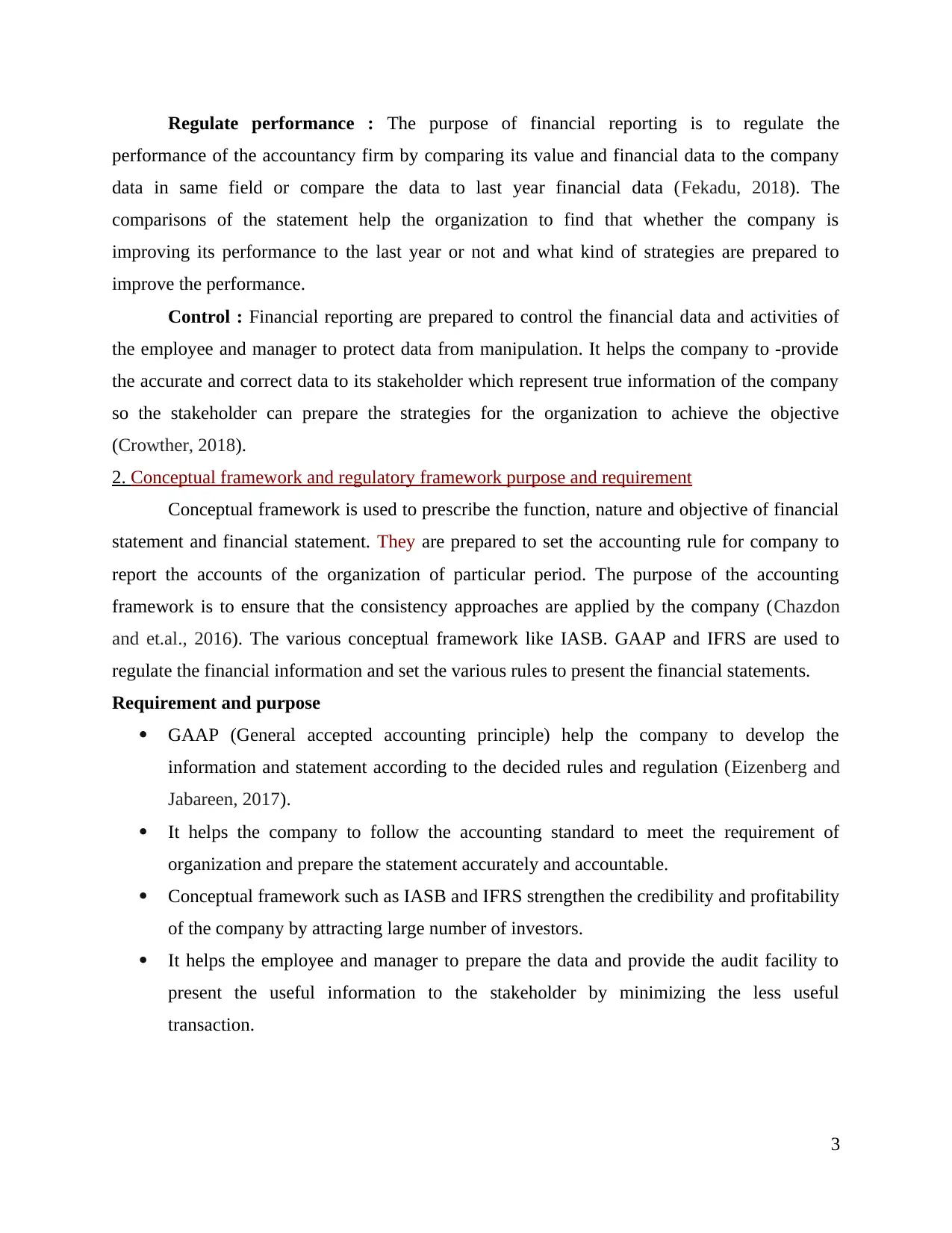
Regulate performance : The purpose of financial reporting is to regulate the
performance of the accountancy firm by comparing its value and financial data to the company
data in same field or compare the data to last year financial data (Fekadu, 2018). The
comparisons of the statement help the organization to find that whether the company is
improving its performance to the last year or not and what kind of strategies are prepared to
improve the performance.
Control : Financial reporting are prepared to control the financial data and activities of
the employee and manager to protect data from manipulation. It helps the company to -provide
the accurate and correct data to its stakeholder which represent true information of the company
so the stakeholder can prepare the strategies for the organization to achieve the objective
(Crowther, 2018).
2. Conceptual framework and regulatory framework purpose and requirement
Conceptual framework is used to prescribe the function, nature and objective of financial
statement and financial statement. They are prepared to set the accounting rule for company to
report the accounts of the organization of particular period. The purpose of the accounting
framework is to ensure that the consistency approaches are applied by the company (Chazdon
and et.al., 2016). The various conceptual framework like IASB. GAAP and IFRS are used to
regulate the financial information and set the various rules to present the financial statements.
Requirement and purpose
GAAP (General accepted accounting principle) help the company to develop the
information and statement according to the decided rules and regulation (Eizenberg and
Jabareen, 2017).
It helps the company to follow the accounting standard to meet the requirement of
organization and prepare the statement accurately and accountable.
Conceptual framework such as IASB and IFRS strengthen the credibility and profitability
of the company by attracting large number of investors.
It helps the employee and manager to prepare the data and provide the audit facility to
present the useful information to the stakeholder by minimizing the less useful
transaction.
3
performance of the accountancy firm by comparing its value and financial data to the company
data in same field or compare the data to last year financial data (Fekadu, 2018). The
comparisons of the statement help the organization to find that whether the company is
improving its performance to the last year or not and what kind of strategies are prepared to
improve the performance.
Control : Financial reporting are prepared to control the financial data and activities of
the employee and manager to protect data from manipulation. It helps the company to -provide
the accurate and correct data to its stakeholder which represent true information of the company
so the stakeholder can prepare the strategies for the organization to achieve the objective
(Crowther, 2018).
2. Conceptual framework and regulatory framework purpose and requirement
Conceptual framework is used to prescribe the function, nature and objective of financial
statement and financial statement. They are prepared to set the accounting rule for company to
report the accounts of the organization of particular period. The purpose of the accounting
framework is to ensure that the consistency approaches are applied by the company (Chazdon
and et.al., 2016). The various conceptual framework like IASB. GAAP and IFRS are used to
regulate the financial information and set the various rules to present the financial statements.
Requirement and purpose
GAAP (General accepted accounting principle) help the company to develop the
information and statement according to the decided rules and regulation (Eizenberg and
Jabareen, 2017).
It helps the company to follow the accounting standard to meet the requirement of
organization and prepare the statement accurately and accountable.
Conceptual framework such as IASB and IFRS strengthen the credibility and profitability
of the company by attracting large number of investors.
It helps the employee and manager to prepare the data and provide the audit facility to
present the useful information to the stakeholder by minimizing the less useful
transaction.
3
Paraphrase This Document
Need a fresh take? Get an instant paraphrase of this document with our AI Paraphraser
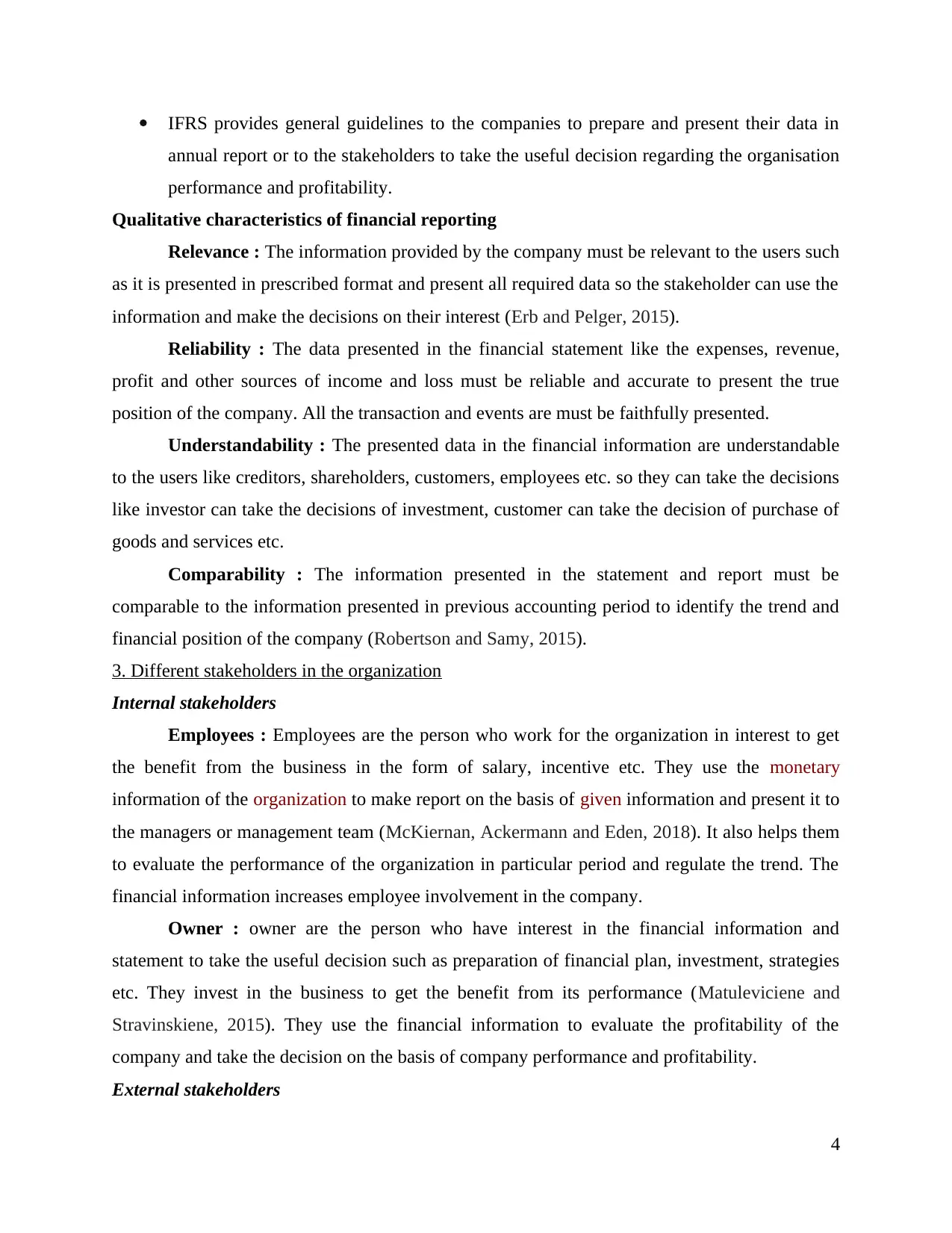
IFRS provides general guidelines to the companies to prepare and present their data in
annual report or to the stakeholders to take the useful decision regarding the organisation
performance and profitability.
Qualitative characteristics of financial reporting
Relevance : The information provided by the company must be relevant to the users such
as it is presented in prescribed format and present all required data so the stakeholder can use the
information and make the decisions on their interest (Erb and Pelger, 2015).
Reliability : The data presented in the financial statement like the expenses, revenue,
profit and other sources of income and loss must be reliable and accurate to present the true
position of the company. All the transaction and events are must be faithfully presented.
Understandability : The presented data in the financial information are understandable
to the users like creditors, shareholders, customers, employees etc. so they can take the decisions
like investor can take the decisions of investment, customer can take the decision of purchase of
goods and services etc.
Comparability : The information presented in the statement and report must be
comparable to the information presented in previous accounting period to identify the trend and
financial position of the company (Robertson and Samy, 2015).
3. Different stakeholders in the organization
Internal stakeholders
Employees : Employees are the person who work for the organization in interest to get
the benefit from the business in the form of salary, incentive etc. They use the monetary
information of the organization to make report on the basis of given information and present it to
the managers or management team (McKiernan, Ackermann and Eden, 2018). It also helps them
to evaluate the performance of the organization in particular period and regulate the trend. The
financial information increases employee involvement in the company.
Owner : owner are the person who have interest in the financial information and
statement to take the useful decision such as preparation of financial plan, investment, strategies
etc. They invest in the business to get the benefit from its performance (Matuleviciene and
Stravinskiene, 2015). They use the financial information to evaluate the profitability of the
company and take the decision on the basis of company performance and profitability.
External stakeholders
4
annual report or to the stakeholders to take the useful decision regarding the organisation
performance and profitability.
Qualitative characteristics of financial reporting
Relevance : The information provided by the company must be relevant to the users such
as it is presented in prescribed format and present all required data so the stakeholder can use the
information and make the decisions on their interest (Erb and Pelger, 2015).
Reliability : The data presented in the financial statement like the expenses, revenue,
profit and other sources of income and loss must be reliable and accurate to present the true
position of the company. All the transaction and events are must be faithfully presented.
Understandability : The presented data in the financial information are understandable
to the users like creditors, shareholders, customers, employees etc. so they can take the decisions
like investor can take the decisions of investment, customer can take the decision of purchase of
goods and services etc.
Comparability : The information presented in the statement and report must be
comparable to the information presented in previous accounting period to identify the trend and
financial position of the company (Robertson and Samy, 2015).
3. Different stakeholders in the organization
Internal stakeholders
Employees : Employees are the person who work for the organization in interest to get
the benefit from the business in the form of salary, incentive etc. They use the monetary
information of the organization to make report on the basis of given information and present it to
the managers or management team (McKiernan, Ackermann and Eden, 2018). It also helps them
to evaluate the performance of the organization in particular period and regulate the trend. The
financial information increases employee involvement in the company.
Owner : owner are the person who have interest in the financial information and
statement to take the useful decision such as preparation of financial plan, investment, strategies
etc. They invest in the business to get the benefit from its performance (Matuleviciene and
Stravinskiene, 2015). They use the financial information to evaluate the profitability of the
company and take the decision on the basis of company performance and profitability.
External stakeholders
4
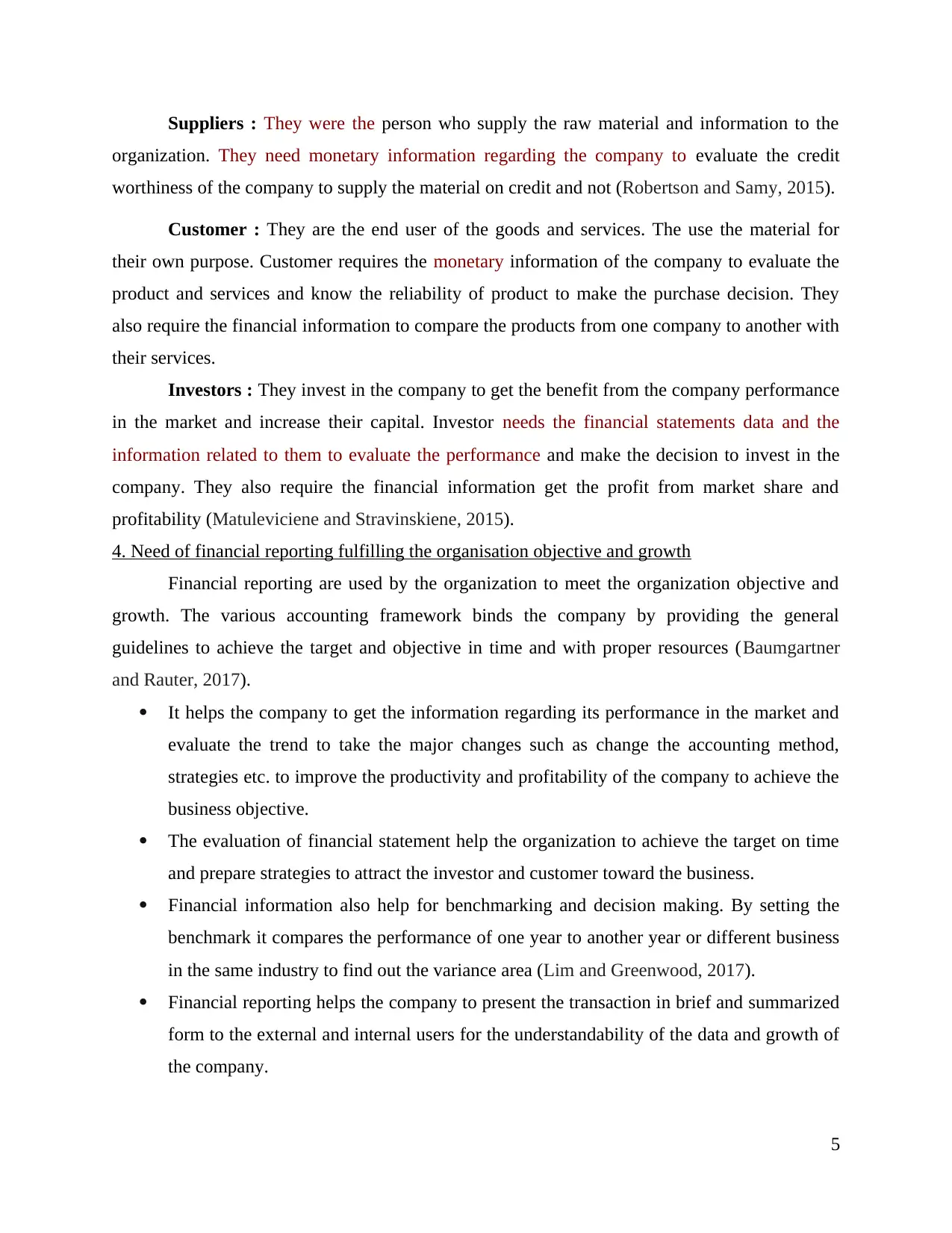
Suppliers : They were the person who supply the raw material and information to the
organization. They need monetary information regarding the company to evaluate the credit
worthiness of the company to supply the material on credit and not (Robertson and Samy, 2015).
Customer : They are the end user of the goods and services. The use the material for
their own purpose. Customer requires the monetary information of the company to evaluate the
product and services and know the reliability of product to make the purchase decision. They
also require the financial information to compare the products from one company to another with
their services.
Investors : They invest in the company to get the benefit from the company performance
in the market and increase their capital. Investor needs the financial statements data and the
information related to them to evaluate the performance and make the decision to invest in the
company. They also require the financial information get the profit from market share and
profitability (Matuleviciene and Stravinskiene, 2015).
4. Need of financial reporting fulfilling the organisation objective and growth
Financial reporting are used by the organization to meet the organization objective and
growth. The various accounting framework binds the company by providing the general
guidelines to achieve the target and objective in time and with proper resources (Baumgartner
and Rauter, 2017).
It helps the company to get the information regarding its performance in the market and
evaluate the trend to take the major changes such as change the accounting method,
strategies etc. to improve the productivity and profitability of the company to achieve the
business objective.
The evaluation of financial statement help the organization to achieve the target on time
and prepare strategies to attract the investor and customer toward the business.
Financial information also help for benchmarking and decision making. By setting the
benchmark it compares the performance of one year to another year or different business
in the same industry to find out the variance area (Lim and Greenwood, 2017).
Financial reporting helps the company to present the transaction in brief and summarized
form to the external and internal users for the understandability of the data and growth of
the company.
5
organization. They need monetary information regarding the company to evaluate the credit
worthiness of the company to supply the material on credit and not (Robertson and Samy, 2015).
Customer : They are the end user of the goods and services. The use the material for
their own purpose. Customer requires the monetary information of the company to evaluate the
product and services and know the reliability of product to make the purchase decision. They
also require the financial information to compare the products from one company to another with
their services.
Investors : They invest in the company to get the benefit from the company performance
in the market and increase their capital. Investor needs the financial statements data and the
information related to them to evaluate the performance and make the decision to invest in the
company. They also require the financial information get the profit from market share and
profitability (Matuleviciene and Stravinskiene, 2015).
4. Need of financial reporting fulfilling the organisation objective and growth
Financial reporting are used by the organization to meet the organization objective and
growth. The various accounting framework binds the company by providing the general
guidelines to achieve the target and objective in time and with proper resources (Baumgartner
and Rauter, 2017).
It helps the company to get the information regarding its performance in the market and
evaluate the trend to take the major changes such as change the accounting method,
strategies etc. to improve the productivity and profitability of the company to achieve the
business objective.
The evaluation of financial statement help the organization to achieve the target on time
and prepare strategies to attract the investor and customer toward the business.
Financial information also help for benchmarking and decision making. By setting the
benchmark it compares the performance of one year to another year or different business
in the same industry to find out the variance area (Lim and Greenwood, 2017).
Financial reporting helps the company to present the transaction in brief and summarized
form to the external and internal users for the understandability of the data and growth of
the company.
5
⊘ This is a preview!⊘
Do you want full access?
Subscribe today to unlock all pages.

Trusted by 1+ million students worldwide
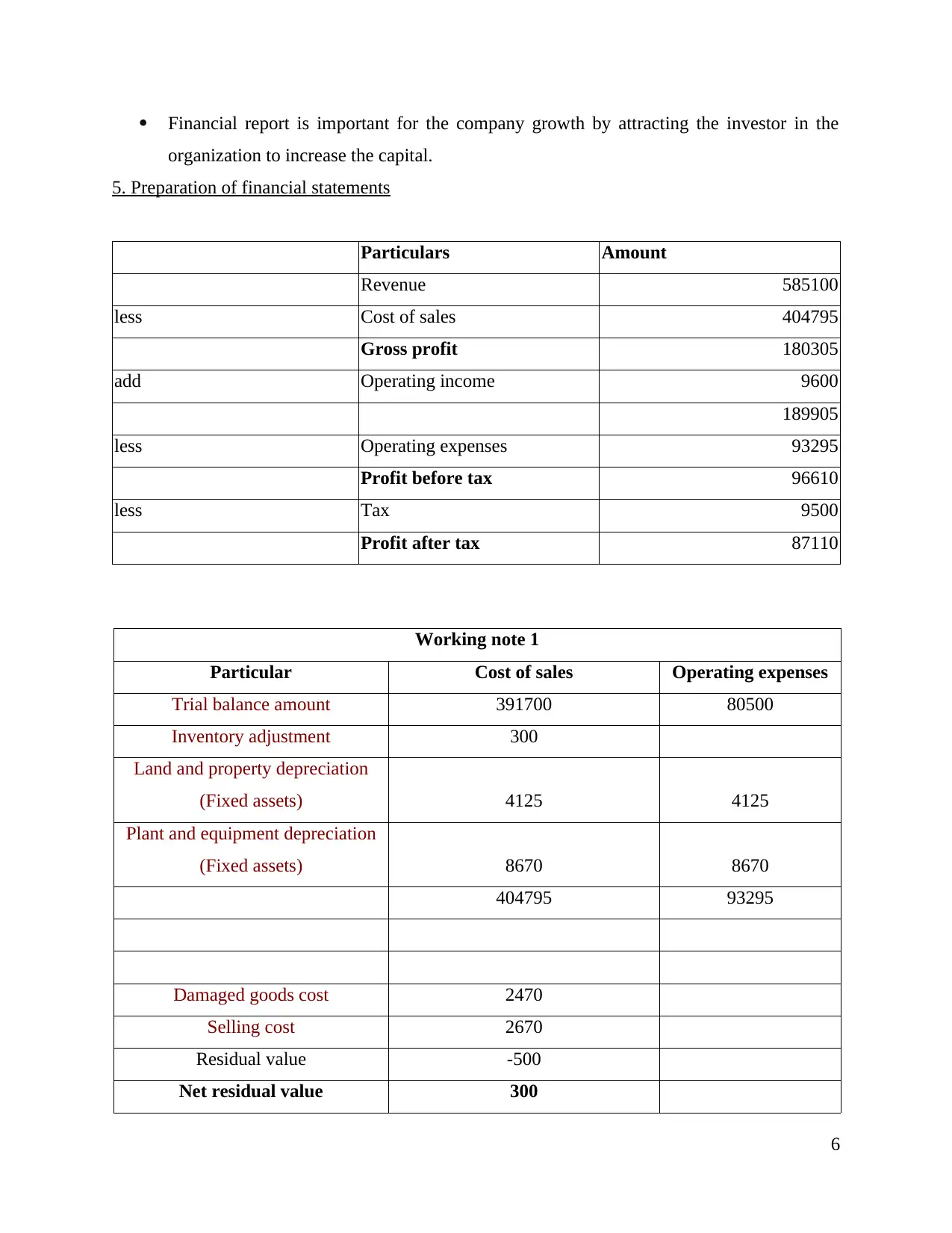
Financial report is important for the company growth by attracting the investor in the
organization to increase the capital.
5. Preparation of financial statements
Particulars Amount
Revenue 585100
less Cost of sales 404795
Gross profit 180305
add Operating income 9600
189905
less Operating expenses 93295
Profit before tax 96610
less Tax 9500
Profit after tax 87110
Working note 1
Particular Cost of sales Operating expenses
Trial balance amount 391700 80500
Inventory adjustment 300
Land and property depreciation
(Fixed assets) 4125 4125
Plant and equipment depreciation
(Fixed assets) 8670 8670
404795 93295
Damaged goods cost 2470
Selling cost 2670
Residual value -500
Net residual value 300
6
organization to increase the capital.
5. Preparation of financial statements
Particulars Amount
Revenue 585100
less Cost of sales 404795
Gross profit 180305
add Operating income 9600
189905
less Operating expenses 93295
Profit before tax 96610
less Tax 9500
Profit after tax 87110
Working note 1
Particular Cost of sales Operating expenses
Trial balance amount 391700 80500
Inventory adjustment 300
Land and property depreciation
(Fixed assets) 4125 4125
Plant and equipment depreciation
(Fixed assets) 8670 8670
404795 93295
Damaged goods cost 2470
Selling cost 2670
Residual value -500
Net residual value 300
6
Paraphrase This Document
Need a fresh take? Get an instant paraphrase of this document with our AI Paraphraser
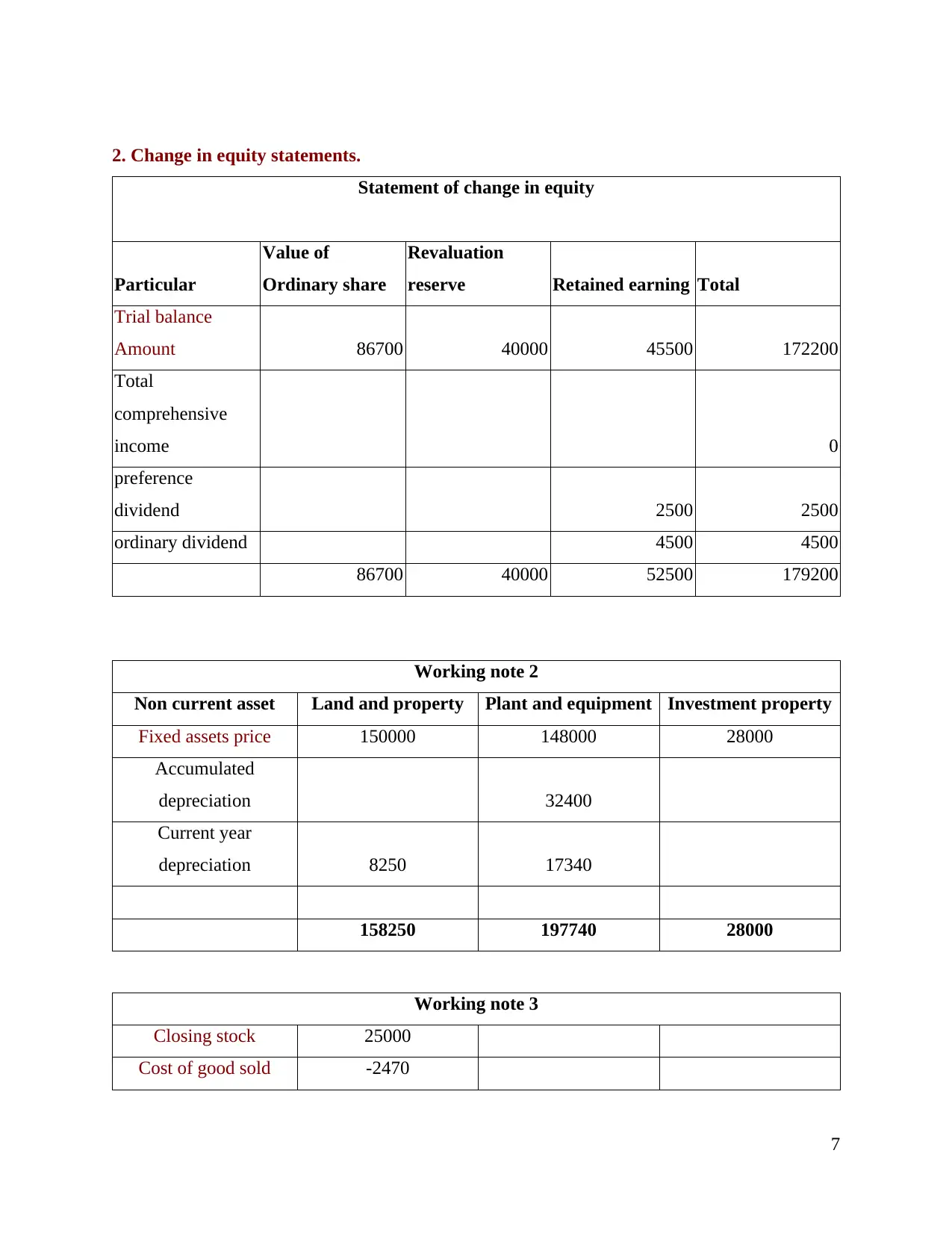
2. Change in equity statements.
Statement of change in equity
Particular
Value of
Ordinary share
Revaluation
reserve Retained earning Total
Trial balance
Amount 86700 40000 45500 172200
Total
comprehensive
income 0
preference
dividend 2500 2500
ordinary dividend 4500 4500
86700 40000 52500 179200
Working note 2
Non current asset Land and property Plant and equipment Investment property
Fixed assets price 150000 148000 28000
Accumulated
depreciation 32400
Current year
depreciation 8250 17340
158250 197740 28000
Working note 3
Closing stock 25000
Cost of good sold -2470
7
Statement of change in equity
Particular
Value of
Ordinary share
Revaluation
reserve Retained earning Total
Trial balance
Amount 86700 40000 45500 172200
Total
comprehensive
income 0
preference
dividend 2500 2500
ordinary dividend 4500 4500
86700 40000 52500 179200
Working note 2
Non current asset Land and property Plant and equipment Investment property
Fixed assets price 150000 148000 28000
Accumulated
depreciation 32400
Current year
depreciation 8250 17340
158250 197740 28000
Working note 3
Closing stock 25000
Cost of good sold -2470
7
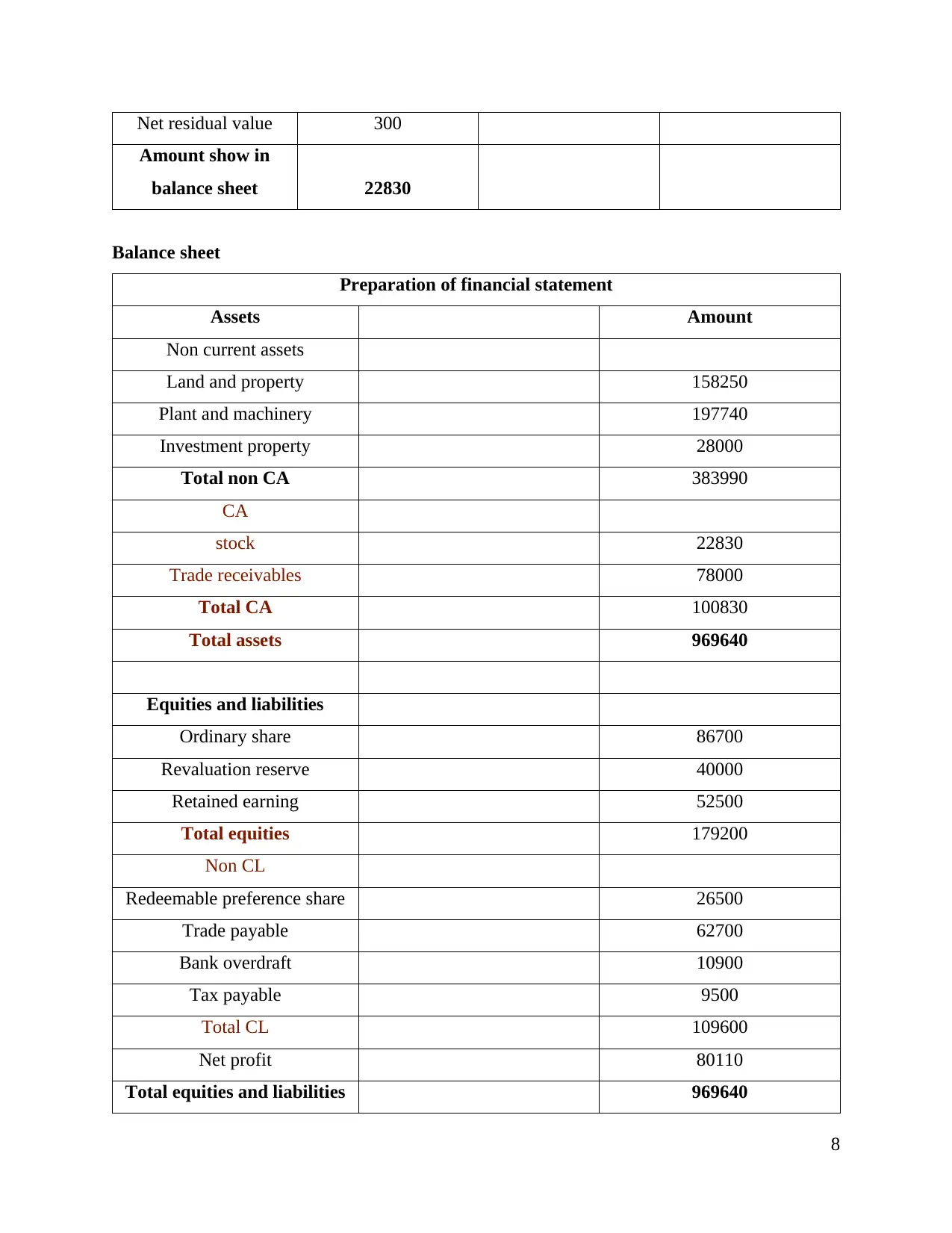
Net residual value 300
Amount show in
balance sheet 22830
Balance sheet
Preparation of financial statement
Assets Amount
Non current assets
Land and property 158250
Plant and machinery 197740
Investment property 28000
Total non CA 383990
CA
stock 22830
Trade receivables 78000
Total CA 100830
Total assets 969640
Equities and liabilities
Ordinary share 86700
Revaluation reserve 40000
Retained earning 52500
Total equities 179200
Non CL
Redeemable preference share 26500
Trade payable 62700
Bank overdraft 10900
Tax payable 9500
Total CL 109600
Net profit 80110
Total equities and liabilities 969640
8
Amount show in
balance sheet 22830
Balance sheet
Preparation of financial statement
Assets Amount
Non current assets
Land and property 158250
Plant and machinery 197740
Investment property 28000
Total non CA 383990
CA
stock 22830
Trade receivables 78000
Total CA 100830
Total assets 969640
Equities and liabilities
Ordinary share 86700
Revaluation reserve 40000
Retained earning 52500
Total equities 179200
Non CL
Redeemable preference share 26500
Trade payable 62700
Bank overdraft 10900
Tax payable 9500
Total CL 109600
Net profit 80110
Total equities and liabilities 969640
8
⊘ This is a preview!⊘
Do you want full access?
Subscribe today to unlock all pages.

Trusted by 1+ million students worldwide
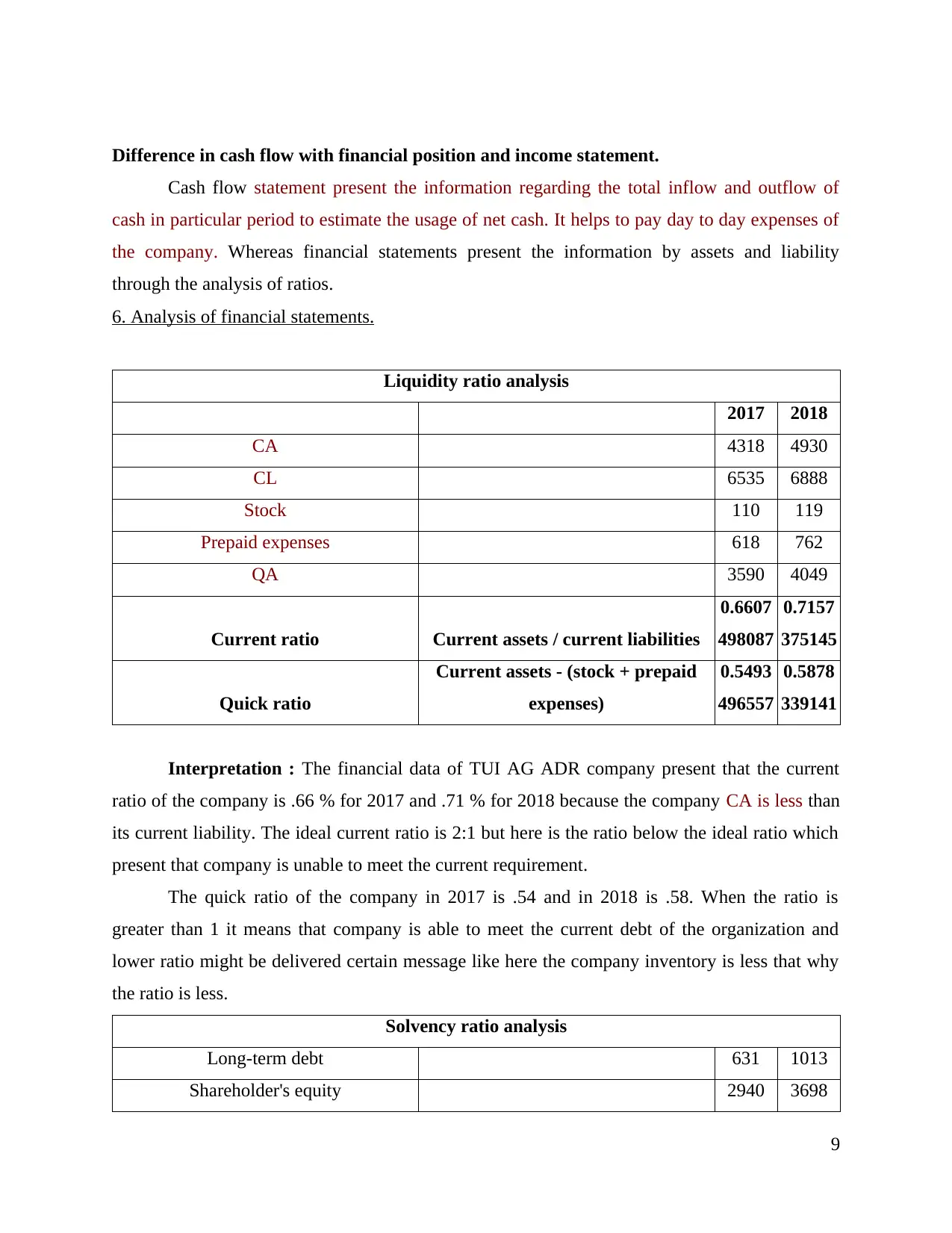
Difference in cash flow with financial position and income statement.
Cash flow statement present the information regarding the total inflow and outflow of
cash in particular period to estimate the usage of net cash. It helps to pay day to day expenses of
the company. Whereas financial statements present the information by assets and liability
through the analysis of ratios.
6. Analysis of financial statements.
Liquidity ratio analysis
2017 2018
CA 4318 4930
CL 6535 6888
Stock 110 119
Prepaid expenses 618 762
QA 3590 4049
Current ratio Current assets / current liabilities
0.6607
498087
0.7157
375145
Quick ratio
Current assets - (stock + prepaid
expenses)
0.5493
496557
0.5878
339141
Interpretation : The financial data of TUI AG ADR company present that the current
ratio of the company is .66 % for 2017 and .71 % for 2018 because the company CA is less than
its current liability. The ideal current ratio is 2:1 but here is the ratio below the ideal ratio which
present that company is unable to meet the current requirement.
The quick ratio of the company in 2017 is .54 and in 2018 is .58. When the ratio is
greater than 1 it means that company is able to meet the current debt of the organization and
lower ratio might be delivered certain message like here the company inventory is less that why
the ratio is less.
Solvency ratio analysis
Long-term debt 631 1013
Shareholder's equity 2940 3698
9
Cash flow statement present the information regarding the total inflow and outflow of
cash in particular period to estimate the usage of net cash. It helps to pay day to day expenses of
the company. Whereas financial statements present the information by assets and liability
through the analysis of ratios.
6. Analysis of financial statements.
Liquidity ratio analysis
2017 2018
CA 4318 4930
CL 6535 6888
Stock 110 119
Prepaid expenses 618 762
QA 3590 4049
Current ratio Current assets / current liabilities
0.6607
498087
0.7157
375145
Quick ratio
Current assets - (stock + prepaid
expenses)
0.5493
496557
0.5878
339141
Interpretation : The financial data of TUI AG ADR company present that the current
ratio of the company is .66 % for 2017 and .71 % for 2018 because the company CA is less than
its current liability. The ideal current ratio is 2:1 but here is the ratio below the ideal ratio which
present that company is unable to meet the current requirement.
The quick ratio of the company in 2017 is .54 and in 2018 is .58. When the ratio is
greater than 1 it means that company is able to meet the current debt of the organization and
lower ratio might be delivered certain message like here the company inventory is less that why
the ratio is less.
Solvency ratio analysis
Long-term debt 631 1013
Shareholder's equity 2940 3698
9
Paraphrase This Document
Need a fresh take? Get an instant paraphrase of this document with our AI Paraphraser
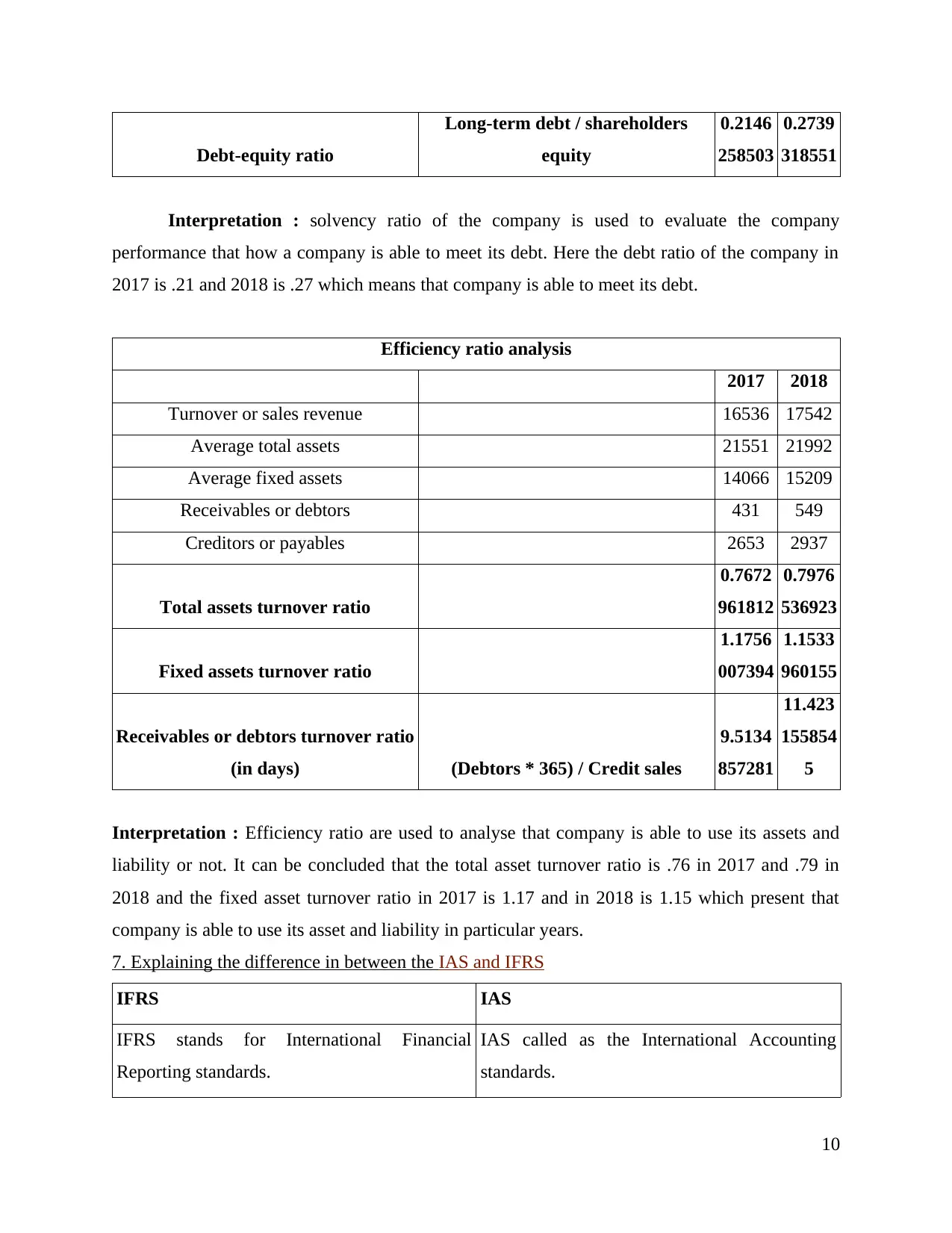
Debt-equity ratio
Long-term debt / shareholders
equity
0.2146
258503
0.2739
318551
Interpretation : solvency ratio of the company is used to evaluate the company
performance that how a company is able to meet its debt. Here the debt ratio of the company in
2017 is .21 and 2018 is .27 which means that company is able to meet its debt.
Efficiency ratio analysis
2017 2018
Turnover or sales revenue 16536 17542
Average total assets 21551 21992
Average fixed assets 14066 15209
Receivables or debtors 431 549
Creditors or payables 2653 2937
Total assets turnover ratio
0.7672
961812
0.7976
536923
Fixed assets turnover ratio
1.1756
007394
1.1533
960155
Receivables or debtors turnover ratio
(in days) (Debtors * 365) / Credit sales
9.5134
857281
11.423
155854
5
Interpretation : Efficiency ratio are used to analyse that company is able to use its assets and
liability or not. It can be concluded that the total asset turnover ratio is .76 in 2017 and .79 in
2018 and the fixed asset turnover ratio in 2017 is 1.17 and in 2018 is 1.15 which present that
company is able to use its asset and liability in particular years.
7. Explaining the difference in between the IAS and IFRS
IFRS IAS
IFRS stands for International Financial
Reporting standards.
IAS called as the International Accounting
standards.
10
Long-term debt / shareholders
equity
0.2146
258503
0.2739
318551
Interpretation : solvency ratio of the company is used to evaluate the company
performance that how a company is able to meet its debt. Here the debt ratio of the company in
2017 is .21 and 2018 is .27 which means that company is able to meet its debt.
Efficiency ratio analysis
2017 2018
Turnover or sales revenue 16536 17542
Average total assets 21551 21992
Average fixed assets 14066 15209
Receivables or debtors 431 549
Creditors or payables 2653 2937
Total assets turnover ratio
0.7672
961812
0.7976
536923
Fixed assets turnover ratio
1.1756
007394
1.1533
960155
Receivables or debtors turnover ratio
(in days) (Debtors * 365) / Credit sales
9.5134
857281
11.423
155854
5
Interpretation : Efficiency ratio are used to analyse that company is able to use its assets and
liability or not. It can be concluded that the total asset turnover ratio is .76 in 2017 and .79 in
2018 and the fixed asset turnover ratio in 2017 is 1.17 and in 2018 is 1.15 which present that
company is able to use its asset and liability in particular years.
7. Explaining the difference in between the IAS and IFRS
IFRS IAS
IFRS stands for International Financial
Reporting standards.
IAS called as the International Accounting
standards.
10
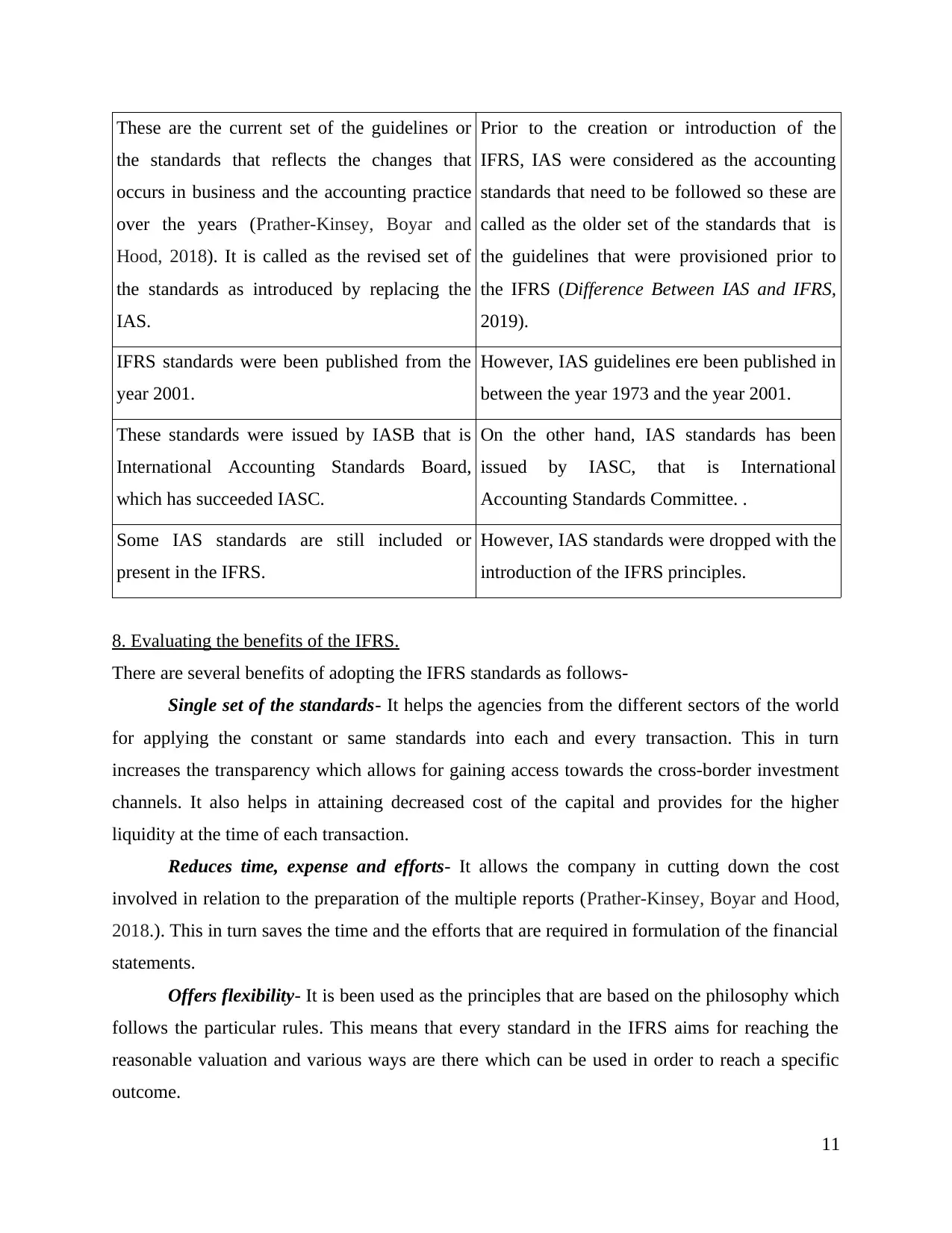
These are the current set of the guidelines or
the standards that reflects the changes that
occurs in business and the accounting practice
over the years (Prather-Kinsey, Boyar and
Hood, 2018). It is called as the revised set of
the standards as introduced by replacing the
IAS.
Prior to the creation or introduction of the
IFRS, IAS were considered as the accounting
standards that need to be followed so these are
called as the older set of the standards that is
the guidelines that were provisioned prior to
the IFRS (Difference Between IAS and IFRS,
2019).
IFRS standards were been published from the
year 2001.
However, IAS guidelines ere been published in
between the year 1973 and the year 2001.
These standards were issued by IASB that is
International Accounting Standards Board,
which has succeeded IASC.
On the other hand, IAS standards has been
issued by IASC, that is International
Accounting Standards Committee. .
Some IAS standards are still included or
present in the IFRS.
However, IAS standards were dropped with the
introduction of the IFRS principles.
8. Evaluating the benefits of the IFRS.
There are several benefits of adopting the IFRS standards as follows-
Single set of the standards- It helps the agencies from the different sectors of the world
for applying the constant or same standards into each and every transaction. This in turn
increases the transparency which allows for gaining access towards the cross-border investment
channels. It also helps in attaining decreased cost of the capital and provides for the higher
liquidity at the time of each transaction.
Reduces time, expense and efforts- It allows the company in cutting down the cost
involved in relation to the preparation of the multiple reports (Prather-Kinsey, Boyar and Hood,
2018.). This in turn saves the time and the efforts that are required in formulation of the financial
statements.
Offers flexibility- It is been used as the principles that are based on the philosophy which
follows the particular rules. This means that every standard in the IFRS aims for reaching the
reasonable valuation and various ways are there which can be used in order to reach a specific
outcome.
11
the standards that reflects the changes that
occurs in business and the accounting practice
over the years (Prather-Kinsey, Boyar and
Hood, 2018). It is called as the revised set of
the standards as introduced by replacing the
IAS.
Prior to the creation or introduction of the
IFRS, IAS were considered as the accounting
standards that need to be followed so these are
called as the older set of the standards that is
the guidelines that were provisioned prior to
the IFRS (Difference Between IAS and IFRS,
2019).
IFRS standards were been published from the
year 2001.
However, IAS guidelines ere been published in
between the year 1973 and the year 2001.
These standards were issued by IASB that is
International Accounting Standards Board,
which has succeeded IASC.
On the other hand, IAS standards has been
issued by IASC, that is International
Accounting Standards Committee. .
Some IAS standards are still included or
present in the IFRS.
However, IAS standards were dropped with the
introduction of the IFRS principles.
8. Evaluating the benefits of the IFRS.
There are several benefits of adopting the IFRS standards as follows-
Single set of the standards- It helps the agencies from the different sectors of the world
for applying the constant or same standards into each and every transaction. This in turn
increases the transparency which allows for gaining access towards the cross-border investment
channels. It also helps in attaining decreased cost of the capital and provides for the higher
liquidity at the time of each transaction.
Reduces time, expense and efforts- It allows the company in cutting down the cost
involved in relation to the preparation of the multiple reports (Prather-Kinsey, Boyar and Hood,
2018.). This in turn saves the time and the efforts that are required in formulation of the financial
statements.
Offers flexibility- It is been used as the principles that are based on the philosophy which
follows the particular rules. This means that every standard in the IFRS aims for reaching the
reasonable valuation and various ways are there which can be used in order to reach a specific
outcome.
11
⊘ This is a preview!⊘
Do you want full access?
Subscribe today to unlock all pages.

Trusted by 1+ million students worldwide
1 out of 14
Related Documents
Your All-in-One AI-Powered Toolkit for Academic Success.
+13062052269
info@desklib.com
Available 24*7 on WhatsApp / Email
![[object Object]](/_next/static/media/star-bottom.7253800d.svg)
Unlock your academic potential
Copyright © 2020–2025 A2Z Services. All Rights Reserved. Developed and managed by ZUCOL.




